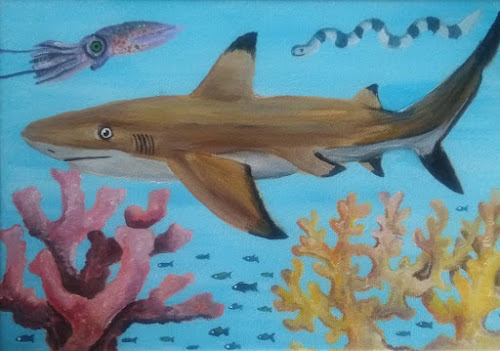Collection: Jaws of the Deep
JAWS OF THE DEEP
Sharks are some of the most powerful predators in the ocean depths. They come in a wide variety of unique shapes and sizes and engaged in various ecological niches. Although their reputation in the media was notorious for their depiction as mindless eating machines, sharks are actually some of the most misunderstood sea creatures, and not all sharks are predators of large prey.
Jaws of the Deep, acrylic on canvas, 2020. Set of 9, each piece 12" X 8.5"
Whale Shark
 |
| Whale Shark, acrylic on canvas, 2020. 12" x 8.5" |
The whale shark (Rhincodon typus) is the largest fish in the sea and the largest shark. The world’s largest sharks are actually gentle filter feeders which feed on plankton and have very tiny teeth. The painting itself is inspired by the animated film Finding Dory, which featured a whale shark named Destiny that was kept in a public aquarium. The painting also contains other animals from the film including Blue Tangs (Paracanthurus hepatus), a giant octopus and an eagle ray.
Smooth Hammerhead Shark
 |
| Smooth Hammerhead Shark, acrylic on canvas, 2020. 12" x 8.5" |
The smooth hammerhead shark (Sphyrna zygaena) is a hammerhead shark that travels in schools in temperate waters. The painting depicts it with two other strange sharks, the spotted wobbegong (Orectolobus maculatus) and the cookiecutter shark (Isistius brasiliensis). A sea squirt and a feather star can be seen in the background.
Horn Shark
 |
| Horn Shark, acrylic on canvas, 2020. 12" x 8.5" |
The horn shark (Heterodontus francisci) is a medium-sized member of the bullhead shark family which is known for the sharp spines on its dorsal fins. The painting shows it swimming alongside sea turtles and a leopard chimaera (Chimaera panthera), a relative of the shark.
Lemon Shark
 |
| Lemon Shark, acrylic on canvas, 2020. 12" x 8.5" |
The lemon shark (Negaprion brevirostris) can be found in shallow waters. Its yellowish coloration, which gave it its name, presents a camouflage adaptation when swimming over the sandy sea floor. It feeds on small creatures that live on the sandy sea floor. The painting shows the shark swimming past a crab and a peacock flounder.
Blacktip Reef Shark
 |
| Blacktip Reef Shark, acrylic on canvas, 2020. 12" x 8.5" |
The blacktip reef shark (Carcharhinus melanopterus) can be easily identified by the black-colored tips on its fins. These sharks can be found in coral reefs and sandy flats, where they share their habitat with various ocean life. It is also a very commonly-seen shark in aquariums. The pictured individual is shown with a bigfin reef squid (Sepioteuthis lessoniana) and a banded sea krait, a species of snake that has adapted to life in the sea.
Bronze Whaler/Copper Shark
 |
| Bronze Whaler, acrylic on canvas, 2020. 12" x 8.5" |
The bronze whaler shark (Carcharhinus brachyurus), also known as the copper shark, is a fast-swimming predator that has been known to hunt in large groups. It was named for its coloration, as well as its feeding habit of scavenging whale carcasses. In the painting, it is shown alongside a whale, a blue-ringed octopus and a spiny dogfish (Squalus anthias), a smaller species of shark.
Oceanic Whitetip Shark
 |
| Oceanic Whitetip Shark, acrylic on canvas, 2020. 12" x 8.5" |
The oceanic whitetip shark (Carcharhinus longimanus) has long, wing-like pectoral and dorsal fins, and is the only known shark that pokes its head out of the water to search for food. The shark in the painting swims alongside an angel shark (Squatina squatina) and a shovelnose guitarfish (Rhinobatos productus), while a jumbo squid and a killer whale are seen in the background. The angel shark and the shovelose guitarfish are specialized feeders on the sea bottom, the former using camouflage to ambush prey while the latter feeds like a stingray.
Tiger Shark
 |
| Tiger Shark, acrylic on canvas, 2020. 12" x 8.5" |
The tiger shark (Galeocerdo cuvier) can be identified by the tiger stripe-like pattern on its body, which fades as the shark reaches maturity. This shark had the widest diet range of all sharks and could even consume inedible objects, including junk. In the painting, the shark is accompanied by several unique sea creatures including a whitetip reef shark (Triaenodon obesus), a pair of Atlantic blue marlin (Makaira nigricans) and a peacock mantis shrimp (Odontodactylus scyllarus) in display pose.
Great White Shark
 |
| Great White Shark, acrylic on canvas, 2020. 12" x 8.5" |
The great white shark (Carcharodon carcharias) is the most powerful predatory shark, made famous by the Jaws film franchise. The shark in the painting is seemingly inspired by a great white shark named Bruce in the animated film, Finding Nemo. In the painting, the shark is followed by smaller, cleaning fish called remora. Remoras are known to stick to the bodies of larger sea animals like sharks, whales, turtles, rays and sea cows, removing parasites and keeping the larger animals clean.




Comments
Post a Comment